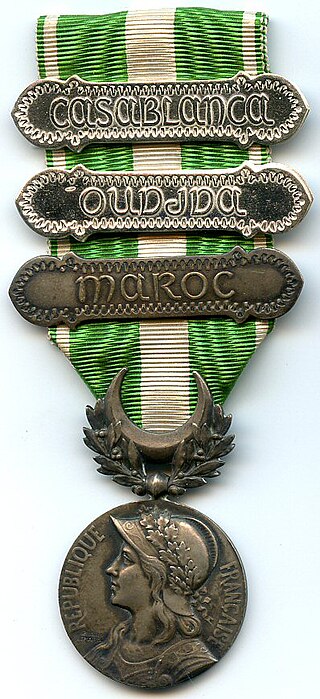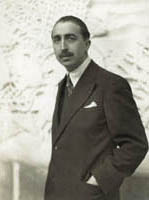
Casablanca, also known in Arabic as Dar al-Bayda is the largest city in Morocco and the country's economic and business center. Located on the Atlantic coast of the Chaouia plain in the central-western part of Morocco, the city has a population of about 3.71 million in the urban area, and over 4.27 million in the Greater Casablanca, making it the most populous city in the Maghreb region, and the eighth-largest in the Arab world.

A craft or trade is a pastime or an occupation that requires particular skills and knowledge of skilled work. In a historical sense, particularly the Middle Ages and earlier, the term is usually applied to people occupied in small scale production of goods, or their maintenance, for example by tinkers. The traditional term craftsman is nowadays often replaced by artisan and by craftsperson (craftspeople).

The French protectorate in Morocco, also known as French Morocco, was the period of French colonial rule in Morocco between 1912 and 1956. The protectorate was officially established 30 March 1912, when Sultan Abd al-Hafid signed the Treaty of Fez, though the French military occupation of Morocco had begun with the invasion of Oujda and the bombardment of Casablanca in 1907.

A medina is a historical district in a number of North African cities, often corresponding to an old walled city. The term comes from the Arabic word simply meaning "city" or "town".
The culture of Morocco is a blend of Arab, Amazighs, Jewish, African and Western European cultures. It represents and is shaped by a convergence of influences throughout history. This sphere may include, among others, the fields of personal or collective behaviors, language, customs, knowledge, beliefs, arts, legislation, gastronomy, music, poetry, architecture, etc. ... While Morocco started to be stably predominantly Sunni Muslim starting from 9th–10th century AD, in the Almoravids empire period, a very significant old Jewish population had contributed to the shaping of Moroccan culture. In antiquity, starting from the second century A.D and up to the seventh, a rural Donatist Christianity was present, along an urban still-in-the-making Roman Catholicism. All of the cultural super strata tend to rely on a multi-millennial aboriginal Berber substratum still strongly present and dating back to prehistoric times.
The International Art and Craft Fair, Ouagadougou – better known by its French name, SIAO – is a trade show for art and handicrafts held biennially in Ouagadougou, the capital of Burkina Faso. It is one of Africa's most important arts and crafts trade shows.

The history of the city of Casablanca in Morocco has been one of many political and cultural changes. At different times it has been governed by Berber, Roman, Arab, Portuguese, Spanish, French, British, and Moroccan regimes. It has had an important position in the region as a port city, making it valuable to a series of conquerors during its early history.

The House of Charm is a historic museum building in Balboa Park, San Diego. It was built for the 1915–16 Panama-California Exposition, and like most buildings from that Exposition it features Mission Revival Style architecture. It acquired its current name, "House of Charm", during the park's second Exposition held in from 1935 to 36. It now houses the San Diego Art Institute and the Mingei International Museum as well as rehearsal space for the Old Globe Theatre. It is listed on the National Register of Historic Places.
The Arts and Crafts Exhibition Society was formed in London in 1887 to promote the exhibition of decorative arts alongside fine arts. The Society's exhibitions were held annually at the New Gallery from 1888 to 1890, and roughly every three years thereafter, were important in the flowering of the British Arts and Crafts Movement in the decades prior to World War I.

The Morocco commemorative medal (1909) was a French military campaign medal. It was established by the law of 22 July 1909 for award to soldiers participating in the Second Franco-Moroccan War under the command of general Hubert Lyautey.

Joseph de La Nézière (1873–1944) was a French painter noted for painting Orientalist scenes and for his work with the French Colonial Office and its program to reform the arts industries in colonial France.

The General Directorate for National Security is the national police force of the Kingdom of Morocco. The DGSN is tasked with upholding the law and public order. It was founded on 16 May 1956 by King Mohammed V. It works alongside the Gendarmerie Royale and the Forces Auxiliaires.

Albert Laprade was a French architect, perhaps best known for the Palais de la Porte Dorée. During a long career he undertook many urban renewal projects as well as major industrial and commercial works. A skilled artist, he published a series of sketch books of architecture in France and other Mediterranean countries.

Dar Batḥa, or Qasr al-Batḥa, is a former royal palace in the city of Fez, Morocco. The palace was commissioned by the Alaouite Sultan Hassan I in the late 19th century and finished under his successor Abdelaziz. It was converted into a museum of historical arts and crafts in 1915 with a collection that now comprises over 6,500 objects. The palace is located near Bab Bou Jeloud at the western edge of Fes el-Bali, the old medina quarter of the city, and close to Fes el-Jdid, the new medina quarter. It is adjacent to the Dar el-Beida palace located to its southeast, which was originally part of the same complex.

The Khalili Imperial Garniture is a trio of cloisonné vases created for a Japanese Imperial commission during the Meiji era. The items were exhibited at the World's Columbian Exposition in Chicago, United States, in 1893, where they were described as "the largest examples of cloisonné enamel ever made". The decoration of the vases represents virtues and the seasons, and also has an allegorical meaning about Japan's role in a changing world and its alliance with the United States. After being exhibited, the vases were separated from each other for more than 120 years, eventually reunited in 2019 in the Khalili Collection of Japanese Art, a private collection assembled by the British-Iranian collector and scholar Nasser D. Khalili.
The School of Fine Arts of Casablanca is a fine arts school established in 1919 in Casablanca, Morocco. It was the origin of the nativist modernist Casablanca School art movement led by faculty members Farid Belkahia, Mohamed Melehi, and Mohamed Chabâa in the 1960s.
The Revolution of the King and the People was a Moroccan anti-colonial national liberation movement with the goal of ending the French Protectorate and the Spanish Protectorate in order to break free from colonial rule. The name refers to the coordination between the Moroccan monarch Sultan Muhammad V and the popular Moroccan Nationalist Movement in efforts against colonialism and toward independence, particularly after the French authorities forced Sultan Muhammad V into exile on August 20, 1953—Eid al-Adha. August 20 is considered as a national holiday in Morocco, in remembrance of the Revolution of the King and the People. After Morocco had regained independence from the French, the movement effectively ceased to exist, as the Sultan managed to take control of the state. Meanwhile, the Moroccan Nationalist Movement was turned into an opposition party.
Jilali Gharbaoui was a Moroccan painter and sculptor from Jorf El Melha. He is considered, along with Ahmed Cherkaoui, a pioneer of modernist art in Morocco. Unlike other Moroccan modernist artists, his abstraction was based in brushstrokes and the "materiality of the paint" as opposed to Moroccan culture. Gharbaoui suffered from severe mental illness and died of suicide in Paris in 1971.

The State Bank of Morocco was a quasi-central bank established in 1907 following the Algeciras Conference, to stabilize the Moroccan currency and serve as a vehicle for European and especially French influence in the Sultanate of Morocco. Following the independence of Morocco, it was replaced in 1959 by the newly created Banque du Maroc, known since 1987 as Bank Al-Maghrib.
















